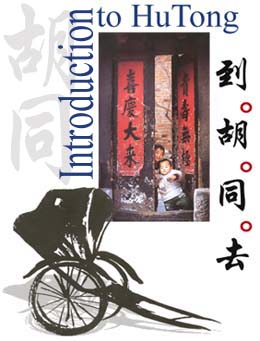
A hutong is an ancient city alley or
lane typical in Beijing, where hutongs run into the several thousand.
Surrounding the Forbidden City, many were built during the Yuan (1206-1341),
Ming(1368-1628) and Qing(1644-1908) dynasties. In the prime of these dynasties
the emperors, in order to establish supreme power for themselves, planned the
city and arranged the residential areas according to the etiquette systems of
the Zhou Dynasty. The center of the city of Beijing was the royal palace -- the
Forbidden City.
O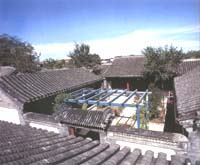 ne kind of hutongs, usually referred to as the regular
hutong, was near the palace to the east and west and arranged in orderly fashion
along the streets. Most of the residents of these hutongs were imperial kinsmen
and aristocrats. Another kind, the simple and crude hutong, was mostly located
far to the north and south of the palace. The residents were merchants and other
ordinary people. ne kind of hutongs, usually referred to as the regular
hutong, was near the palace to the east and west and arranged in orderly fashion
along the streets. Most of the residents of these hutongs were imperial kinsmen
and aristocrats. Another kind, the simple and crude hutong, was mostly located
far to the north and south of the palace. The residents were merchants and other
ordinary people.
The main buildings in the hutong were
almost all quadrangles--a building complex formed by four houses around a
quadrangular courtyard . The quadrangles varied in size and design according to
the social status of the residents. The big quadrangles of high- ranking
officials and wealthy merchants were specially built with roof beams and pillars
all beautifully carved and painted, each with a front yard and back yard.
However, the ordinary people's quadrangles were simply built with small gates
and low houses. hutongs, in fact, are passageways formed by many closely
arranged quadrangles of different sizes. The specially built quadrangles all
face the south for better lighting; as a result, a lot of hutongs run from east
to west. Between the big hutongs many small ones went north and south for
convenient passage.
At the end of the Qing Dynasty unified and closed
China came under influence from abroad, having experienced change of dynasties
and the vicissitudes of life. The stereotyped arrangement of the hutong was also
affected. Many newly formed hutongs with irregular houses appeared outside the
city, while many old ones lost their former neat arrangement. The social status
of the residents also changed, reflecting the collapse of the feudal system.
During the period of the Republic of China (1911-1948), Chinese society was
unstable, with frequent civil wars and repeated foreign invasions.
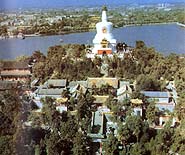 The city of Beijing deteriorated, and the conditions of
the hutong worsened. Quadrangles previously owned by one family became a
compound occupied by many households. The city of Beijing deteriorated, and the conditions of
the hutong worsened. Quadrangles previously owned by one family became a
compound occupied by many households.
After the founding
of the people's Republic of China in 1949, hutong conditions improved. In recent
years, the houses in many hutongs have been pulled down and replaced by modern
buildings. Many hutong dwellers have moved to new housing.
The hutong today is fading into the shade for both tourists and
inhabitants.
However, in the urban district of Beijing
houses along hutongs still occupy one third of the total area, providing housing
for half the population, so many hutongs have survived. In this respect, we see
the old in the new in Beijing as an ancient yet modern
city.
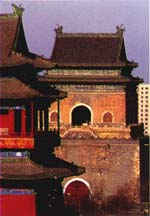 A new pastime -- roaming through Beijing's
old, narrow streets, hutongs, by old-fashioned pedicab to visit siheyuan, the
old quadrangles, and learn about the daily life of ordinary Beijing citizens--
has attracted more and more overseas visitors. A new pastime -- roaming through Beijing's
old, narrow streets, hutongs, by old-fashioned pedicab to visit siheyuan, the
old quadrangles, and learn about the daily life of ordinary Beijing citizens--
has attracted more and more overseas visitors.
Existed as
early as hundreds of years ago, narrow lanes, or hutongs were common in ancient
Beijing. In the past, several thousand lanes, alleys and quadrangles formed
residential areas for ordinary people living in the capital. Today,as the city
develops into an international metropolis, its lanes and alleyways, occupying
one third of the city proper, still serve as dwellings for half the total urban
population.
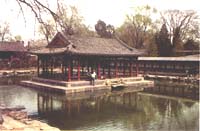 If sightseeing at the Imperial Palace, Ming
Tombs and the Summer Palace is helpful in learning about the lives of China's
emperors, the hutongs of Beijing reflect in turn the history of Beijing as a
whole. If sightseeing at the Imperial Palace, Ming
Tombs and the Summer Palace is helpful in learning about the lives of China's
emperors, the hutongs of Beijing reflect in turn the history of Beijing as a
whole.
A day tour through hutongs gives you fresh insight
into Beijing's local life.
* Start from the north
entrance to Beihai Park by old-fashioned pedicab to the picturesque
Shishahai Lake area.
* Visit Gu
Lou, the Drum Tower, where visitors will enjoy a
bird's eye view of the old city.
* Visit the neighbourhood
in the rear Shishahai Lake area and walk in hutongs to drop in one or two
courtyard- style homes and, if arranged, meal with a
family.
* Visit the mansion and garden of Prince
Gong of the Qing Dynasty.
The Drum
Tower was first built in 1272 during the reign of Kublai Khan (the
first emperor of the Yuan Dynasty), and reconstructed in 1420 when the Ming
Dynasty established its capital in Beijing. It rises from a brick podium with a
tower pierced by six gates and topped by a roof of soaring
eaves.
To the north is the Bell Tower,
first constructed in 1420 and rebuilt of bricks in 1747 during the reign of
Emperor Qianlong. The original iron bell was replaced by a great bronze bell,
which was rung at seven o'clock evening until
1924.
The mansion is the most exquisitely
decorated and best preserved among the princes' mansions in Beijing, and beside
the residence there is also a large garden.
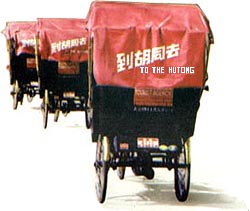 The mansion consists of two parts: living
quarters and the garden, covering 56,000 square meters. The living quarters run
along three axes - central, eastern and western, altogether having 1,000 rooms.
People can imagine the grandeur from its green glazed- tile
roofs. The mansion consists of two parts: living
quarters and the garden, covering 56,000 square meters. The living quarters run
along three axes - central, eastern and western, altogether having 1,000 rooms.
People can imagine the grandeur from its green glazed- tile
roofs.
The garden of Prince Gong's
Mansion covers 25,000 square meters, with artificial rockeries, covered
corridors and pavilions. It is said the Grand View Garden described in the novel
"A Dream of Red Mansions" was modelled after this garden.
The lake is a broad expanse of water surrounded by willows, locust trees and
poplars - a lovely scene. People can have a boat ride there in summer and skate
in winter.
hotel
nearby
Beijing Red Wall Hotel
Beijing
Shatan Hotel
Ping An Fu
Hotel, Beijing
|
